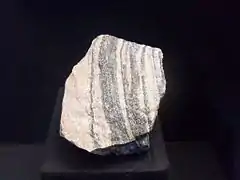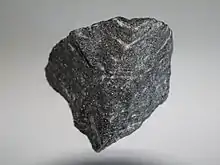Acasta Gneiss
The Acasta Gneiss is a tonalite gneiss in the Slave craton in Northwest Territories, Canada. The rock body is exposed on an island about 300 kilometres north of Yellowknife. The rock of the outcrop was metamorphosed 3.58 to 4.031 billion years ago and is the oldest known intact crustal fragment on Earth.[1]


First described in 1989, it was named for the nearby Acasta River east of Great Bear Lake. The Acasta outcrop is found in a remote area of the Tłı̨chǫ people land settlement. It is the oldest known exposed rock in the world.
Formation
The metamorphic rock exposed in the outcrop was previously a granitoid that formed 4.03 billion years ago, an age based on radiometric dating of zircon crystals at 4.031 Ga.[2][3] The Acasta Gneiss is important in establishing the early history of the continental crust. Acasta Gneiss was formed in the Basin Groups unofficial period of the Hadean eon, which came before the Archean: see Timetable of the Precambrian.
Contention for record
In 2008 an age of 4.28 billion years was reported for an outcrop in the Nuvvuagittuq Greenstone Belt on the eastern shores of Hudson Bay, 40 kilometres south of Inukjuak, Quebec, Canada.[4] However, the dating method used did not involve similar radiometric dating of zircon crystals and it remains somewhat contentious whether the reported date represents the age that the rock itself formed or a residual isotopic signature of older material that melted to form the rock.[5]
Mafic rocks from the Nuvvuagittuq Greenstone Belt have recorded isotopic compositions that can be produced only in the Hadean eon (i.e. older than 4 billion years ago) and the complete isotopic study of all the lithologies included in the Nuvvuagittuq Greenstone Belt suggests that it was formed nearly 4.4 billion years ago.[6]
Exhibit
- In 2003 a team from the Smithsonian Institution collected a four-tonne boulder of Acasta Gneiss for display outside the National Museum of the American Indian in Washington, D.C. Another sample is on display in the Museu de Geociências of the University of Brasília, Brazil.
- In October 2016, a sample of Acasta Gneiss was placed on public display at the Clark Planetarium in Salt Lake City, Utah, USA alongside samples of stromatolite and banded iron formation.
- In 2006, Peter Skinner and Bert Cervo contributed a small sample of the rock to the Six String Nation project. Part of that material was inlaid into the first fret of Voyageur,[7] the guitar at the heart of the project.
See also
- Age of the Earth
References
- Bowring, S.A., and Williams, I.S., 1999. Priscoan (4.00–4.03 Ga) orthogneisses from northwestern Canada. Contributions to Mineralogy and Petrology, v. 134, 3–16
- Bowring, Samuel; Williams, Ian (2007-03-01). "Priscoan (4.00–4.03 Ga) orthogneisses from northwestern Canada". Contributions to Mineralogy and Petrology. 134 (1): 3–16. doi:10.1007/s004100050465.
- Iizuka, Tsuyoshi; Komiya, Tsuyoshi; Ueno, Yuichiro; Katayama, Ikuo; Uehara, Yosuke; Maruyama, Shigenori; Hirata, Takafumi; Johnson, Simon P.; Dunkley, Daniel J. (2007-03-01). "Geology and zircon geochronology of the Acasta Gneiss Complex, northwestern Canada: New constraints on its tectonothermal history". Precambrian Research. 153 (3–4): 179–208. doi:10.1016/j.precamres.2006.11.017.
- "World's oldest rocks found in Quebec". The Gazette. September 25, 2008. Archived from the original on 2008-09-26. Retrieved 2008-09-25.
- Discovery of world’s oldest rocks challenged, New Scientist, 26 September 2008
- O'Neil, Jonathan; Carlson, Richard W.; Paquette, Jean-Louis; Francis, Don (2012-11-01). "Formation age and metamorphic history of the Nuvvuagittuq Greenstone Belt". Precambrian Research. 220–221: 23–44. doi:10.1016/j.precamres.2012.07.009.
- Jowi., Taylor (2009). Six string nation : 64 pieces, 6 strings, 1 Canada, 1 guitar. Vancouver: Douglas & McIntyre. ISBN 9781553653936. OCLC 302060380.
Bibliography
- Stern, R.A., Bleeker, W., 1998. Age of the world's oldest rocks refined using Canada's SHRIMP. the Acasta gneiss complex, Northwest Territories, Canada. Geoscience Canada, v. 25, pp. 27–31